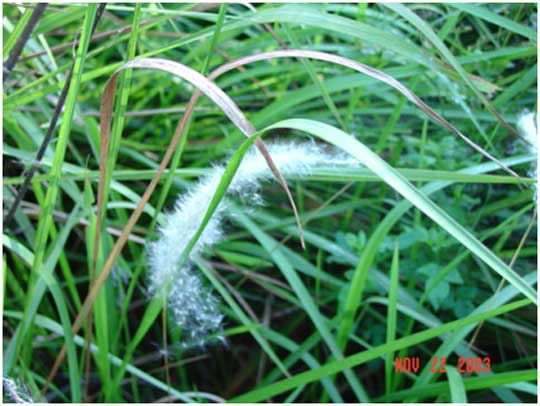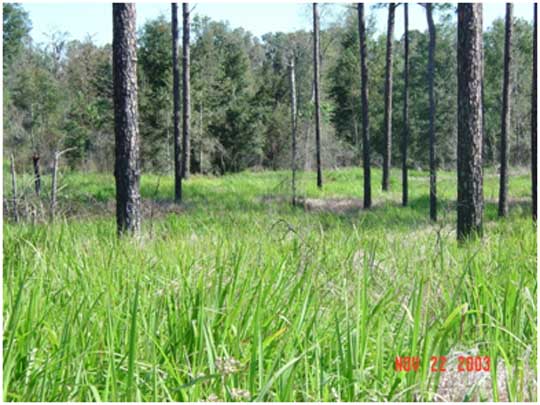What Is That Grass?
June 4, 2008
From the Escambia County Extension Office
During this time of year, Extension offices throughout Florida get many calls and visits by people wondering what that bright grass is with the pretty seedhead. This non-native and highly invasive plant is COGONGRASS, also called Jap Grass, was introduced to this country back around 1911 as seed in packing material.
From its humble start, it has spread throughout the Southeast and is now considered a noxious weed in both Florida and Alabama. Cogongrass is a species adapted to fire; it thrives where fire is a regular occurrence, will burn hot and can kill seedling and mature trees.
Cogongrass spreads by both wind-blown seeds and underground creeping rhizomes. The rhizomes can form a dense mat in the upper six to eight inches (to a maximum depth of 12 to 24 inches) of soil and may comprise as much as 80 percent of the total plant mass. It is the rhizome system that makes this plant particularly hard to control. Elimination of above ground portions of the plant can be easily accomplished, but if the rhizomes are not killed or removed, rapid re-sprouting and regrowth will occur.
How can you identify cogongrass?
 Right now, an easy identification tool is the fluffly white seedheads like the photo to the left (click to enlarge). The plant can flower at other times of the year, especially if the stand has been burnt, mowed, or otherwise disturbed. Each seedhead can contain 3000 seeds that are easily dispersed by the wind.
Right now, an easy identification tool is the fluffly white seedheads like the photo to the left (click to enlarge). The plant can flower at other times of the year, especially if the stand has been burnt, mowed, or otherwise disturbed. Each seedhead can contain 3000 seeds that are easily dispersed by the wind.
The leaves are rarely a dark green color. More often, the leaves are more yellow-green. The leaves can turn reddish in the fall. Another identifying characteristic is the offset midrib on the leaf blade (see photo at bottom of page). The midrib is usually a bit off-centered on the leaf. The margin of the leaf is rough feeling due to serrations. This plant is unpalatable to animals because of the rough leaves, low nutrients, and high silica content in the leaves.
How can you control cogongrass?
Mechanical Control
There is no foolproof method to controlling this weed. In young infestations, tillage can sometimes keep cogongrass from an area if continued during the course of a growing season. The initial tillage should begin in the spring (March through May) with an implement that inverts the soil to a depth of at least six inches. Perform additional tillage with a disk harrow or other appropriate implement every six to eight weeks. It is important to clean all equipment on site to prevent the spread by rhizomes.
Dry periods during the summer will aid in the control of cogongrass. The area can be planted to a fall cover crop and then followed the next season with perennial or annual grass or broadleaf crops. Mowing may help reduce cogongrass stands, but areas must be mowed frequently and at a low height. Monitor the site throughout the growing season; spot treat any recurring infestations with appropriate herbicides.
Chemical Control
There are only two chemicals that have some efficacy on this weed: Glyphosate and Imazapyr. Even with high rates and tank mixing, these chemicals RARELY will totally eliminate all the cogongrass in the treated area. Repeat applications are often necessary. Yes, I wrote applications with an “S”. It can often take more than one, two, or three shots to get this weed down.
If you are using glyphosate, the best time to first start treatment is during the Fall. A word of caution: imazapyr has soil residual activity. Many species that you will try to plant in the treated area will be injured if planting within 24 months of treating. It will also cause more problems to trees than glyphosate. ALWAYS read the label before applying either of the herbicides and follow the recommended rates. The label is the LAW.
If you need more information about cogongrass, please contact your local Extension office or refer to the two websites listed below. If you have cogongrass problems in your woods, contact your county forester for recommendations on treatment.
This article was based on information from the University of Florida EDIS publication: http://edis.ifas.ufl.edu/pdffiles/WG/WG20200.pdf and University of Georgia: http://www.cogongrass.org/cogongrasspub.pdf
For more information:
Libbie Johnson, Escambia County Extension 850.475.5230 libbiej@ufl.edu
Adam Parden, Escambia County Forester 850.587.5123 pardena@doacs.state.fl.us
Article from Libbie Johnson, Escambia County Extension for NorthEscambia.com
Photos by Clyde Smith, Jackson County Extension





Comments